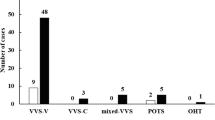Abstract
The aim of this study was to clarify the association of clinical characteristics of unexplained syncope with the outcome of the head-up tilt test (HUT) in children. A total of 47 patients with unexplained syncope were classified into two groups according to their outcomes of HUT: the positive response group and the negative response group. We reviewed their clinical data as well as the results of HUT and analyzed them with logistic regression method. The results showed that the incidence of positive responses to HUT was higher in girls than in boys (8/22 vs 10/7, p < 0.05). Compared with fainted children younger than 12 years of age, 12- to 16-year-old adolescents with unexplained syncope had a high positive outcome of HUT (30 vs 72.9%, p < 0.05). Compared with fainted children with negative response of HUT, children with positive response to HUT often had syncope in special circumstances (e.g., prolonged standing, anxiety and fright, and morning exercise), and they often had prodrome, such as pallor, lightheadedness, and nausea (28/30 vs 8/17, p < 0.05). However, the number and duration of syncopal spells did not relate to the positive responses to HUT. The logistic regression analysis showed that three factors significantly influenced the outcome of HUT: predisposing factors of syncope, prodrome of syncope, and age (p < 0.05; OR = 32.9434, 17.7281, and 2.7842, respectively). Hence, if pubertal girls with unexplained syncope had clear predisposing factors and prodromes, they were likely to have positive responses to HUT, and they were likely to be clinically considered as having vasovagal syncope.
Similar content being viewed by others
References
P Blair MD Grubb (1999) ArticleTitlePathophysiology and differential diagnosis of neurocardiogenic syncope. Am J Cardiol 84 3Q–9Q Occurrence Handle10568555
DJ Driscoll SJ Jacobsen CJ Porter PC Wollan (1997) ArticleTitleSyncope in children and adolescents. J Am Coll Cardiol 29 1039–1045 Occurrence Handle10.1016/S0735-1097(97)00020-X Occurrence Handle1:STN:280:ByiB2cvkt1U%3D Occurrence Handle9120157
CL Johnsrude (2000) ArticleTitleCurrent approach to pediatric syncope. Pediatr Cardiol 21 522–531 Occurrence Handle10.1007/s002460010130 Occurrence Handle1:STN:280:DC%2BD3M%2Fltl2rtA%3D%3D Occurrence Handle11050276
D Junbao M Zhao L Wanzhen et al. (1999) ArticleTitleA study on head-up tilt test for the diagnosis of unexplained syncope in children. Cardiovasc Eng 4 8–10
MM Levine (1999) ArticleTitleNeurally mediated syncope in children: results of tilt testing, treatment, and long-term follow-up. Pediatr Cardiol 20 331–335 Occurrence Handle10.1007/s002469900479 Occurrence Handle1:STN:280:DyaK1MzntlCisA%3D%3D Occurrence Handle10441686
LA Lipsiz J Mietus GB Moody AL Goldberger (1990) ArticleTitleSpectral characteristics of heart rate variability before and during postural tilt: relations to aging and risk of syncope. Circulation 81 1830–1810
G Muller BJ Deal JF Strasburger DW Benson Jr (1993) ArticleTitleUsefulness of metoprolol for unexplained syncope and positive response to tilt testing in young persons. Am J Cardiol 71 592–595 Occurrence Handle10.1016/0002-9149(93)90517-G Occurrence Handle1:STN:280:ByyC2srjsVE%3D Occurrence Handle8438747
S Richard M Daniel (1999) ArticleTitleIndication, methodology, and classification of results of tilt-table testing. Am J Cardiol 84 10Q–16Q Occurrence Handle10.1016/S0002-9149(99)00692-X Occurrence Handle10568556
JK Ronald (1999) syncope. P Gillette A Garson (Eds) Clinical Pediatric Arrthythmias, 2nd edn. Saunders Philadelphia 251–286
S Rose ML Koshman R McDonald et al. (1996) ArticleTitleHealth-related quality of life in patients with neuromediated syncope. Can J Cardiol 12 131–138
RS Sheldon (1994) ArticleTitleEffects of aging on response to isoprotenol tilt-table testing in patients with syncope. J Am Coll Cardiol 19 773–779
R Sheldon (1994) ArticleTitleEffects of aging on responses to isoprotenol tilt-table testing in patients with syncope. Am J Cardiol 7 459–463 Occurrence Handle10.1016/0002-9149(94)90903-2
R Sheldon S Rose P Flanagan ML Koshman S Killam (1996) ArticleTitleRisk factors for syncope recurrent after a positive tilt table test in patients with syncope. Circulation 93 973–981 Occurrence Handle1:STN:280:BymC2sbgt1w%3D Occurrence Handle8598089
Acknowledgements
This work was supported by Capital Medical Development Foundation of China Grant 2001-3037.
Author information
Authors and Affiliations
Corresponding author
Rights and permissions
About this article
Cite this article
Qingyou, Z., Junbao, D., Jianjun, C. et al. Association of Clinical Characteristics of Unexplained Syncope with the Outcome of Head-Up Tilt Tests in Children. Pediatr Cardiol 25, 360–364 (2004). https://doi.org/10.1007/s00246-003-0513-4
Published:
Issue Date:
DOI: https://doi.org/10.1007/s00246-003-0513-4




